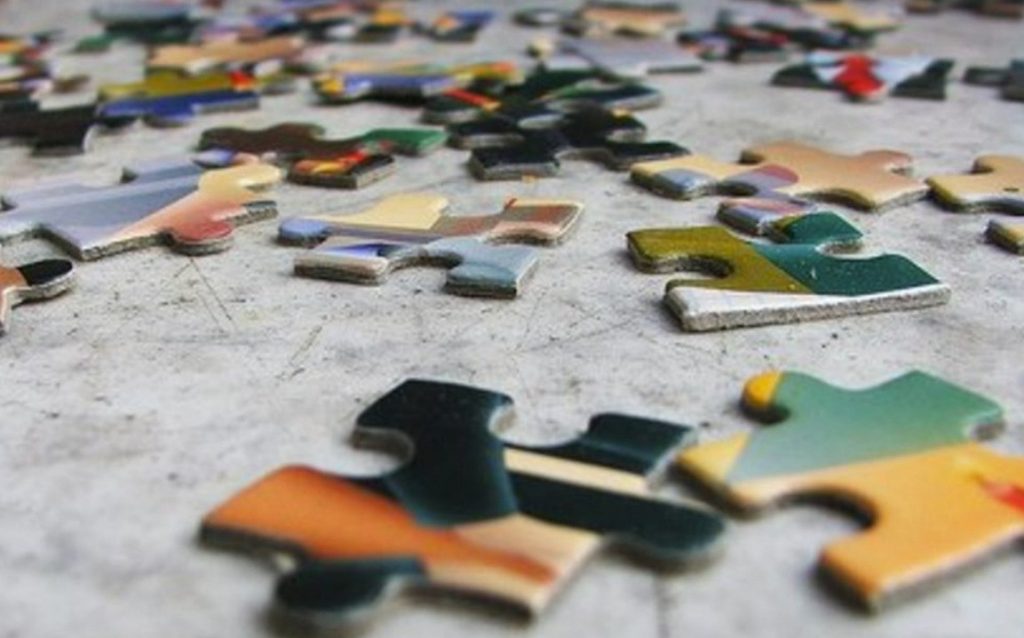The unassuming jigsaw puzzle, with its promise of a satisfying challenge and a complete picture waiting to be revealed, has entertained and engaged minds for centuries. But where and when did this ingenious pastime first take root? A captivating journey through history unveils the evolution of jigsaw puzzles, from their humble beginnings as educational tools to cherished family activities.

Part 1: The Origins of Dissected Maps (1760s)
1. John Spilsbury and Educational Puzzles:
The story of jigsaw puzzles can be traced back to the 1760s and a London cartographer named John Spilsbury. Spilsbury is credited with creating the first known jigsaw puzzle, although it wasn’t quite the colorful and playful image we associate with puzzles today. Spilsbury’s puzzle was a map, typically a world map, pasted onto a piece of wood and then carefully cut along the borders of countries. These “dissected maps,” as they were called, served an educational purpose, helping students learn geography in a more interactive way.
2. Beyond Maps – The Rise of Variety:
Spilsbury’s map may have been the first piece, but the puzzle craze spread like wildfire! Crafty individuals took the concept and ran with it, creating puzzles that depicted all sorts of fascinating subjects. Imagine piecing together a religious scene revered in your community, a famous landmark you longed to visit, or even a portrait of a beloved leader. These early puzzles were handcrafted works of art, each piece meticulously cut from wood. This intricate process, however, made them expensive luxuries. Only the wealthy could afford such a prized possession, leaving the dream of puzzling out of reach for most.
Part 2: The Industrial Revolution and the Rise of Mass Production (1800s)
1. The Jigsaw Takes Shape (1855):
The year 1855 marked a turning point for jigsaw puzzles with the invention of the jigsaw itself! This saw, with its narrow blade, allowed for more detailed and precise cuts. Puzzle makers could now create intricate designs with fantastical shapes, unlike the simpler cuts possible before. However, despite this exciting development, the puzzles themselves remained largely wooden, handcrafted luxuries. This meant that while the potential for amazing puzzles grew, the high cost kept them out of reach for most people.
2. The Rise of Paper Puzzles (Late 1800s):
The late 19th century saw a breakthrough with the introduction of paper-based puzzles. These puzzles were significantly cheaper to produce than their wooden counterparts, making them more readily available to the general public. The use of lithography, a printing technique that allowed for high-quality reproductions of images, further fueled the popularity of paper puzzles. This period saw the rise of puzzle manufacturers who catered to a growing demand for this new form of family entertainment.

Part 3: The Golden Age of Jigsaw Puzzles (Early 20th Century)
1. The Term “Jigsaw Puzzle” Takes Hold:
Forget “jigsaw puzzle,” these brain teasers were originally called “dissected puzzles” or just plain “puzzles” in the early days! It wasn’t until the 1900s that the term “jigsaw puzzle” became the norm. This shift likely happened because the “jigsaw” saw, invented in 1855, became the go-to tool for creating intricate puzzle pieces. The association between the saw and the intricate cuts in the puzzles solidified the term, making “jigsaw puzzle” a household name and cementing its place in popular culture.
2. Innovation and Expansion:
The early 1900s marked a golden age for jigsaw puzzles. It was a time of exciting innovation! Manufacturers, eager to meet the growing demand for family entertainment, experimented with different materials, shapes, and even the number of pieces included in a puzzle. Die-cutting machines revolutionized puzzle production, allowing for mass creation of precisely shaped pieces that fit together perfectly. This replaced the time-consuming hand-cutting methods of the past. Another key advancement was the use of sturdier cardboard as the base material. This not only reduced production costs but also made puzzles more durable and less prone to warping. The combination of these advancements, along with the public’s growing desire for engaging activities, propelled jigsaw puzzles from niche luxury items to a cherished household staple.

Part 4: Jigsaw Puzzles in the Modern Era (Mid 20th Century – Present)
1. New Materials and Technologies:
The mid-20th century ushered in a material revolution for jigsaw puzzles! Gone were the days of puzzles susceptible to warping and wear. Plywood, a sturdier alternative to wood, became a popular choice, offering increased durability for those precious puzzle moments. But the innovation didn’t stop there. Plastic even entered the scene, providing an option for puzzles that could withstand enthusiastic little hands. These new materials weren’t the only upgrade. Advancements in printing technology blossomed alongside them. Puzzle images exploded with vibrant colors and intricate details, making the completed picture even more stunning and the assembly process even more visually rewarding.
2. Jigsaw Puzzles for All Ages and Interests:
The world of jigsaw puzzles today is a kaleidoscope of choice! Gone are the days of one-size-fits-all. Manufacturers cater to every puzzler, from wide-eyed youngsters to seasoned puzzle masters. Themes range from dinosaurs and Disney princesses for children to breathtaking landscapes and historical scenes for adults. Difficulty levels are just as diverse, offering a gentle challenge for beginners or a mind-bending experience for puzzle aficionados with thousands of pieces. Jigsaw puzzles remain a cherished activity for individuals and families alike. They provide a refreshing escape from the digital world, a chance to connect and collaborate, and the ultimate satisfaction of seeing the final piece click into place, a small triumph for the mind and a testament to perseverance.

Part 5: A Legacy of Entertainment and Education
Jigsaw puzzles have come a long way from their humble beginnings as educational tools. They have evolved into a beloved form of entertainment, offering intellectual stimulation, relaxation, and a sense of accomplishment for people of all ages. Whether you’re piecing together a nostalgic childhood scene or tackling a complex landscape puzzle, the act of assembling a jigsaw puzzle provides a unique blend of challenge and satisfaction. The legacy of jigsaw puzzles lies in their ability to bridge the gap between education and entertainment, offering a timeless activity that continues to capture our imaginations and bring people together. So, the next time you have a quiet evening, gather your family or friends, and delve into the world of jigsaw puzzles. You might be surprised at the joy and sense of accomplishment that awaits as you piece together a small part of history, one intricate piece at a time.
